Hypertrophy training is a style of training that focuses on building as much muscle as possible.
While many people think that hypertrophy workout plans revolve around doing endless sets of high-rep weight training, the reality is that hypertrophy workouts and strength workouts aren’t all that different.
Just like any good strength training plan, a good hypertrophy program includes time-proven exercises that allow you to lift heavy and get progressively stronger over time.
The best hypertrophy programs include just enough hard training each week to get your muscles to grow, but not so much that you can’t effectively recover from your workouts.
That’s what you’ll learn how to do in this article.
You’ll learn everything you need to know about muscle hypertrophy, including the best hypertrophy workout plan you can follow, the best exercises for hypertrophy training, and my top five hypertrophy training tips.
Table of Contents
Hypertrophy Training 101
1. Prioritize compound exercises.
A compound exercise is any type of exercise that trains several major muscle groups at the same time, like the squat, deadlift, and bench and overhead press.
Research shows that if you want to maximize muscle hypertrophy, nothing beats compound weightlifting.
Exercises that involve just one joint and major muscle group at a time—also known as isolation exercises—can still have a place in your program, but if hypertrophy is your main goal, you should put most of your energy into compound exercises.
2. Emphasize progressive overload.
If you stop getting stronger, your muscles will eventually stop getting bigger.
That’s why you should always strive to add weight or reps to every exercise in every workout.
This is known as progressive overload, and it’s one of the best ways to maximize the muscle-building effects of weightlifting.
This is also why low-reps are generally a little better than high-reps for hypertrophy training. Doing most of your sets in the 4-to-10 rep range allows you to add weight and reps more frequently and the workouts tend to be less fatiguing than if you did most of your sets in the 10+ rep range. This generally works out to around 75-to-85% of your one-rep max.
That said, high-rep sets (10+) still have a place in a hypertrophy program, but they should be used sparingly.
3. Do the right number of sets each week.
Studies show that if you want to maximize muscle hypertrophy, you want to do around 10-to-20 sets per muscle group per week.
What’s more, if you run into a muscle gain plateau, research shows that bumping up your training volume for that muscle group by about 20% is a good way to kickstart progress. For example, if you haven’t been able to gain much muscle or strength in your chest doing 10 sets per week, you’d add two more sets per week.
If you aren’t sure how to calculate your weekly set volume, don’t worry. The hypertrophy workout plan below will have you doing the right number of sets for each muscle group per week.
The Best Hypertrophy Workout Program
The following is a tried-and-tested, 5-day per week hypertrophy workout program that’s been used by natural bodybuilders to build mass for decades.
The reason it works so well is that it has you doing all the best mass-building exercises and it uses the right number of weekly sets to promote hypertrophy without wearing you to a frazzle.
If the 5-day per week hypertrophy program doesn’t fit your schedule, you can shorten it to a 4-day routine by skipping Day 5. And if you’d prefer to do a 3-day routine, skip Day 3 and Day 5.
Day 1: Push
- Barbell Bench Press: 3 sets of 4-to-6 reps with 2-to-3 min rest
- Incline Barbell Bench Press: 3 sets of 4-to-6 reps with 2-to-3 min rest
- Dumbbell Bench Press: 3 sets of 8-to-10 reps with 2-to-3 min rest
- Triceps Pushdown: 3 sets of 8-to-10 reps with 2-to-3 min rest
Day 2: Pull
- Barbell Deadlift: 3 sets of 4-to-6 reps with 2-to-3 min rest
- One-Arm Dumbbell Row: 3 sets of 8-to-10 reps with 2-to-3 min rest
- Lat Pulldown: 3 sets of 8-to-10 reps with 2-to-3 min rest
- Seated Cable Row: 3 sets of 8-to-10 reps with 2-to-3 min rest
Day 3: Upper A
- Seated Dumbbell Press: 3 sets of 4-to-6 reps with 2-to-3 min rest
- Alternating Dumbbell Curl: 3 sets of 8-to-10 reps with 2-to-3 min rest
- Dumbbell Side Lateral Raise: 3 sets of 8-to-10 reps with 2-to-3 min rest
- Dumbbell Rear Lateral Raise: 3 sets of 8-to-10 reps with 2-to-3 min rest
Day 4: Lower
- Barbell Back Squat: 3 sets of 4-to-6 reps with 2-to-3 min rest
- Leg Press: 3 sets of 4-to-6 reps with 2-to-3 min rest
- Lying Leg Curl: 3 sets of 8-to-10 reps with 2-to-3 min rest
- Seated Calf Raise: 3 sets of 8-to-10 reps with 2-to-3 min rest
Day 5: Upper B
- Close-Grip Bench Press: 3 sets of 4-to-6 reps with 2-to-3 min rest
- Weighted Pull-up: 3 sets of 4-to-6 reps with 2-to-3 min rest
- Dumbbell Overhead Triceps Extension: 3 sets of 8-to-10 reps with 2-to-3 min rest
- Barbell Curl: 3 sets of 8-to-10 reps with 2-to-3 min rest
The 20 Best Hypertrophy Exercises
Barbell Bench Press
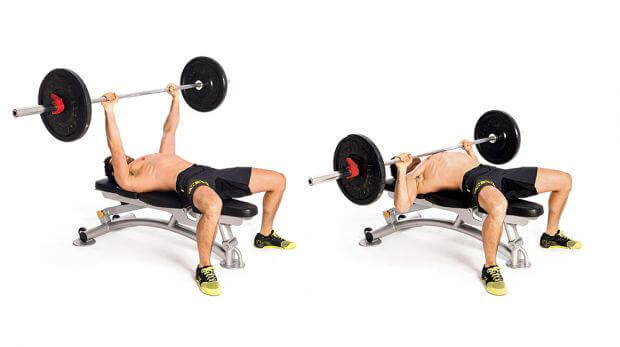
Sets: 3 | Reps: 4 to 6 | Rest: 2-to-3 min
Lie on a flat bench with your feet flat on the floor, grab the bar with a slightly wider than shoulder-width grip, and unrack the barbell. Bring the barbell to the middle of your chest, then explosively press the bar back to the starting position.
Incline Barbell Bench Press
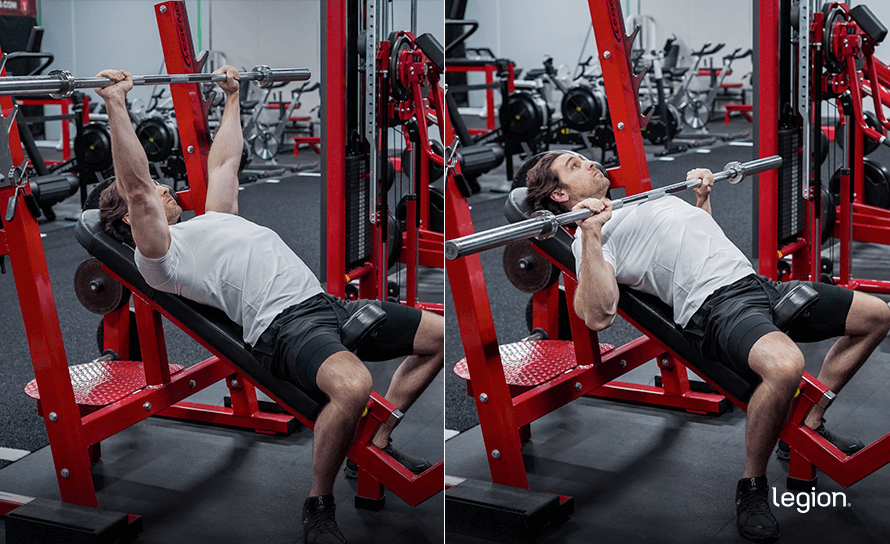
Sets: 3 | Reps: 4 to 6 | Rest: 2-to-3 min
Lie on a bench that’s angled at 30-to-45 degrees with your feet flat on the floor, grab the bar with a slightly wider than shoulder-width grip, and unrack the barbell. Bring the barbell to the middle of your chest and then explosively press the bar back to the starting position.
Dumbbell Bench Press
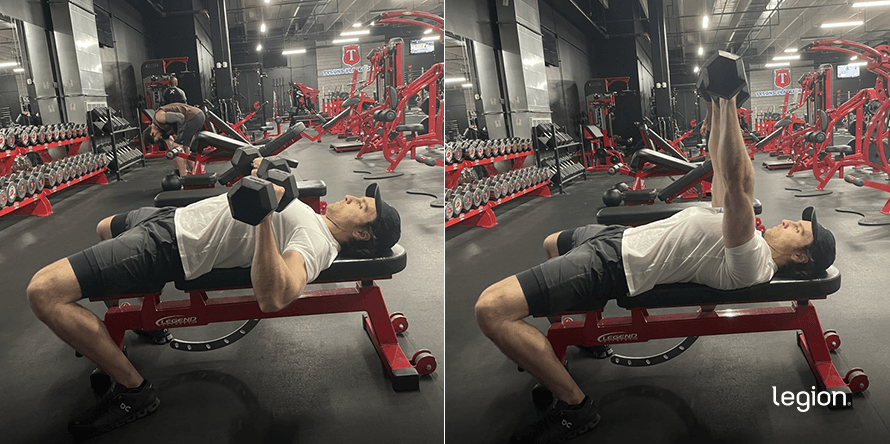
Sets: 3 | Reps: 8 to 10 | Rest: 2-to-3 min
While sitting on a flat bench, hold a dumbbell in each hand and rest them on your thighs. Lie back and bring the dumbbells up so you’re holding them on either side of your chest. Press the dumbbells straight up over your chest until your arms are straight and your elbows are almost locked, then lower the dumbbells to the starting position.
Triceps Pushdown
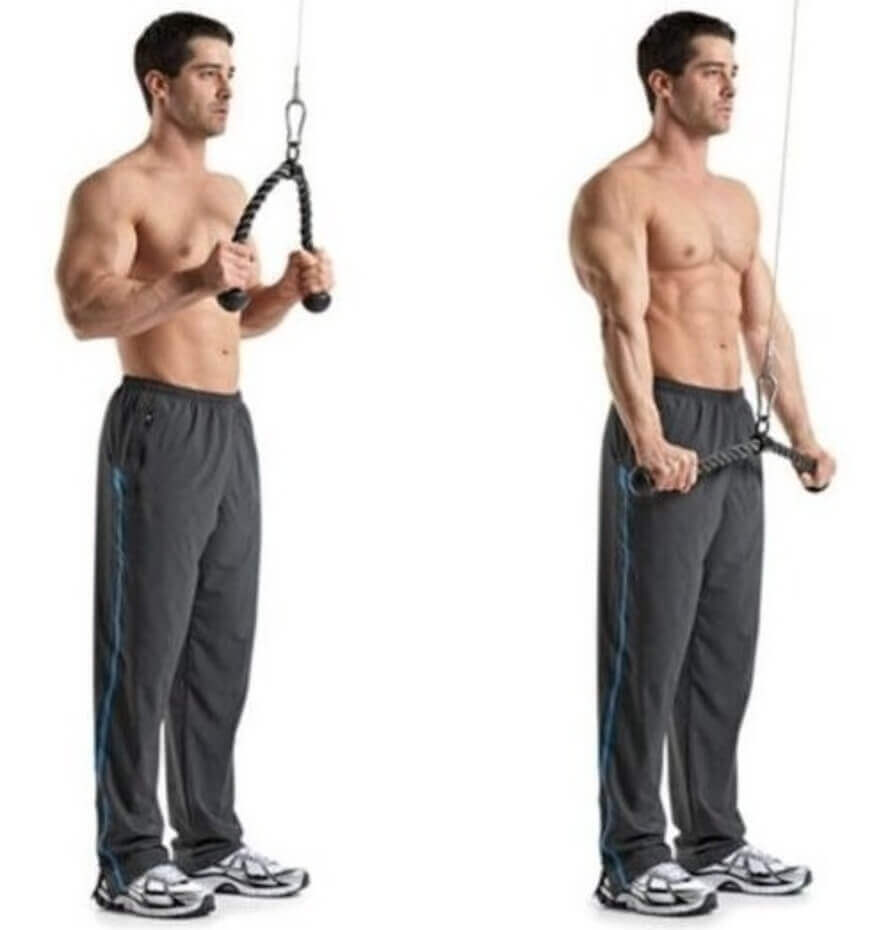
Sets: 3 | Reps: 8 to 10 | Rest: 2-to-3 min
Set the pulley on a cable machine to slightly above head height and attach the rope handle. Grab one end of the rope in each hand, lean forward slightly, and push the rope downward by straightening your elbows. Once your arms are straight and at your sides, reverse the movement and return to the starting position.
Barbell Deadlift
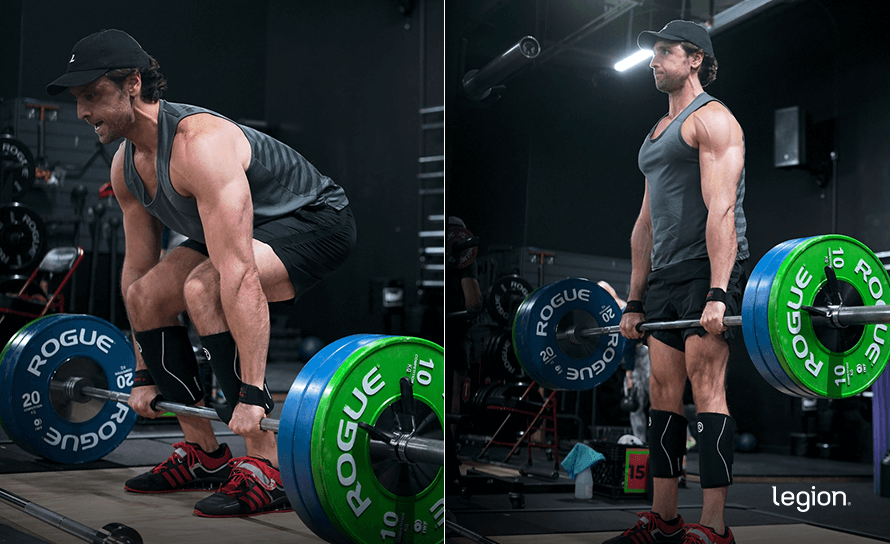
Sets: 3 | Reps: 4 to 6 | Rest: 2-to-3 min
Load a barbell on the floor and position your feet under the bar so they’re slightly narrower than shoulder-width apart with your toes pointed slightly out. Move down toward the bar by pushing your hips back and place your hands on the bar just outside your shins. Drive your body upward and slightly back by pushing through your heels, then reverse the movement and return to the starting position.
One-Arm Dumbbell Row
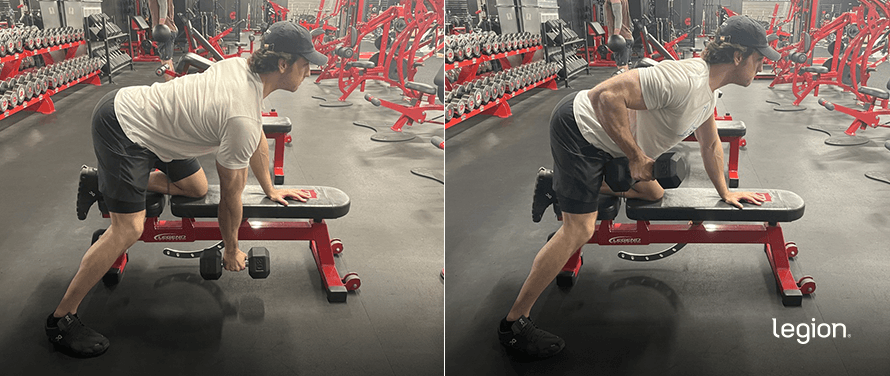
Sets: 3 | Reps: 4 to 6 | Rest: 2-to-3 min
Hold a dumbbell in your right hand. Then, bend over and put your left hand and left knee on a bench, allowing your right arm to extend toward the floor. Keeping your back straight, pull the dumbbell upward until it touches your torso, then return the dumbbell to the starting position. Once you’ve completed the desired number of reps, repeat the process with your left arm.
Lat Pulldown
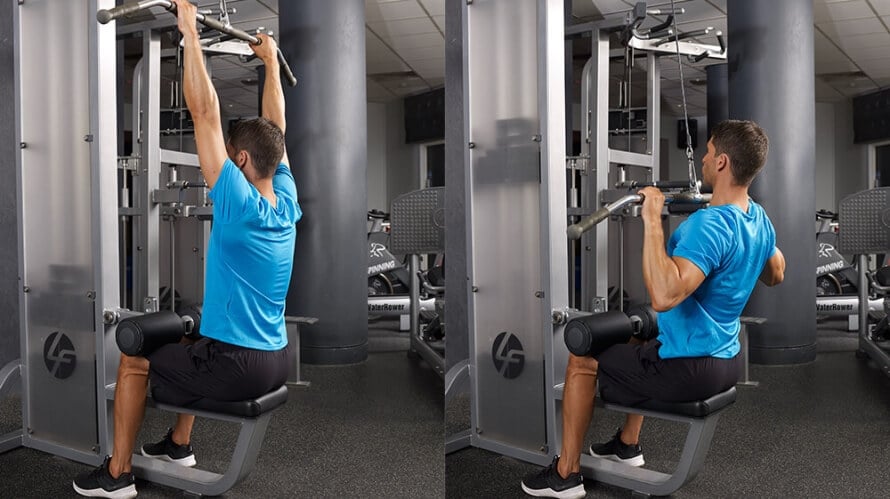
Sets: 3 | Reps: 8 to 10 | Rest: 2-to-3 min
Stand up and grab the bar of the lat pulldown machine. While keeping your grip on the bar and your arms straight, sit down with your thighs under the thigh pad, allowing your body weight to pull the bar down with you. Without swinging your torso, pull the bar toward your chest, then reverse the movement to return to the starting position.
Seated Cable Row
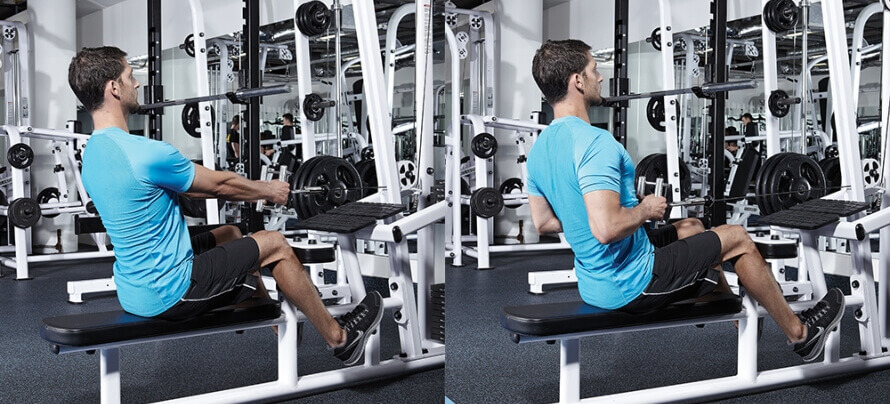
Sets: 3 | Reps: 8 to 10 | Rest: 2-to-3 min
Sit on the pad and place your feet on the footplate while maintaining a slight bend in your knees. Lean forward and grab the handle, then lean back with your arms stretched in front of you. Straighten your back and pull the cable toward your stomach, then reverse the movement and return to the starting position.
Seated Dumbbell Overhead Press
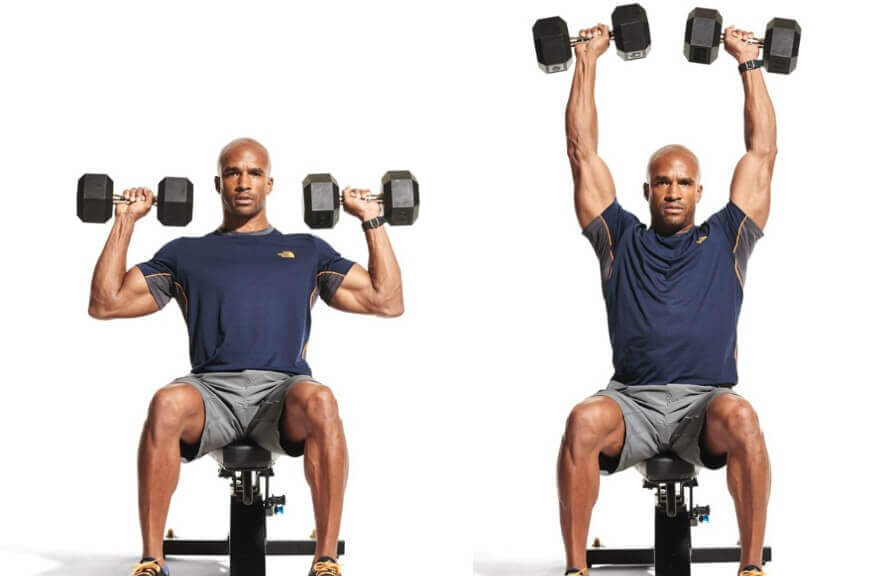
Sets: 3 | Reps: 4 to 6 | Rest: 2-to-3 min
While sitting on an upright bench, hold a dumbbell in each hand and rest them on your thighs. Hoist the dumbbells up so you’re holding them just above your shoulders. Press the dumbbells straight up over your head until your arms are straight and your elbows are locked, then lower the dumbbells to the starting position.
Alternating Dumbbell Curl
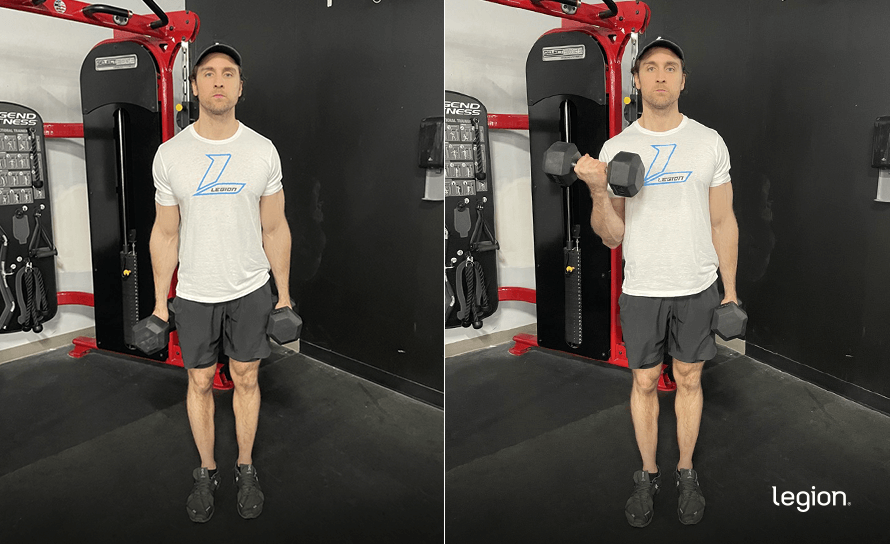
Sets: 3 | Reps: 8 to 10 | Rest: 2-to-3 min
Stand up straight holding a dumbbell in each hand. Keeping your left arm at your side, flex your right arm and curl the dumbbell up until it’s in front of your right shoulder, then lower the dumbbell to the starting position. Then repeat with your left arm until you’ve done the desired number of reps (8-to-10) for both arms.
Dumbbell Side Lateral Raise
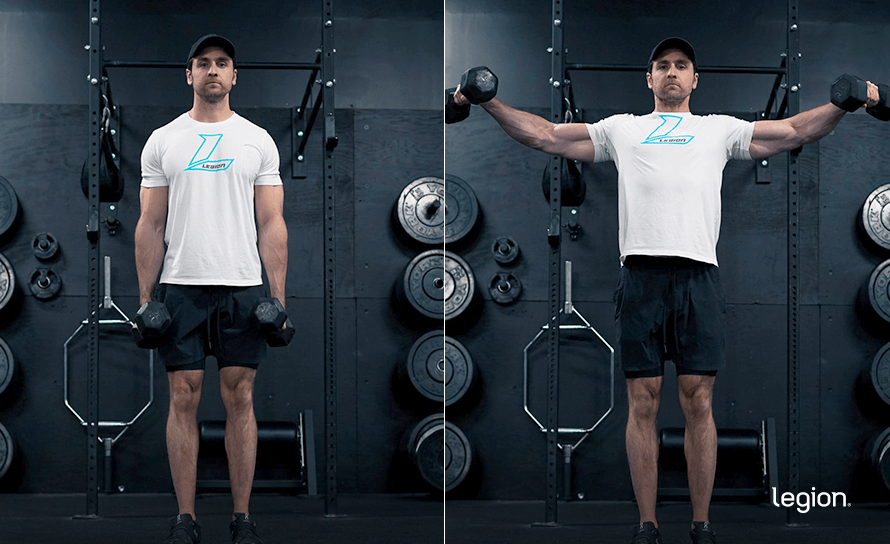
Sets: 3 | Reps: 8 to 10 | Rest: 2-to-3 min
Stand up straight with a dumbbell in each hand. Keeping your arms mostly straight (a slight bend in the elbows is fine), lift the dumbbells out to the side until your upper arms are parallel to the floor. Reverse the movement and return to the starting position.
Dumbbell Rear Lateral Raise
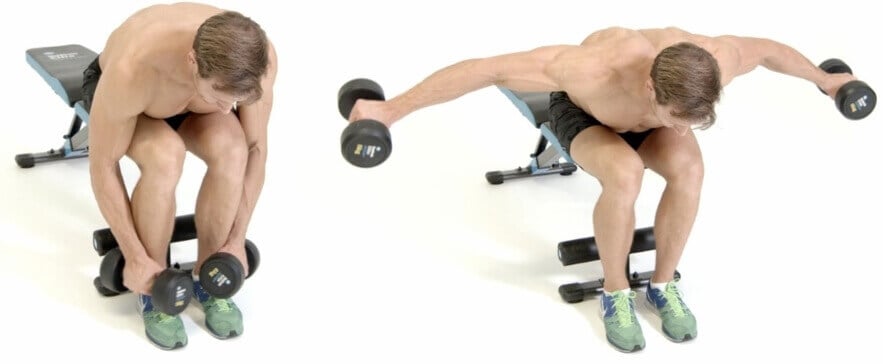
Sets: 3 | Reps: 8 to 10 | Rest: 2-to-3 min
Whether standing or seated, bend at the hips so that your upper body is as close to parallel to the floor as possible. Hold a dumbbell in each hand, and while keeping your back flat, lift the dumbbells out to the side until your upper arms are parallel to the floor. Reverse the movement and return to the starting position.
Barbell Back Squat
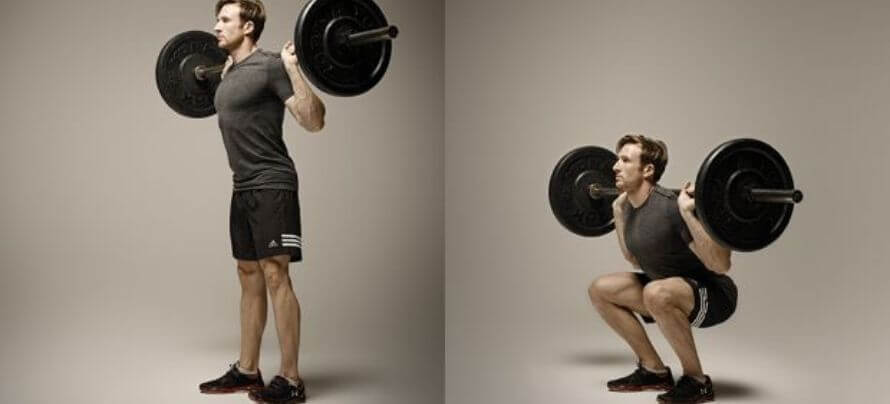
Sets: 3 | Reps: 4 to 6 | Rest: 2-to-3 min
Step under the bar, pinch your shoulder blades together, and rest the bar directly above the bony ridges on the bottom of your shoulder blades. Lift the bar out of the rack, take one or two steps backward, and place your feet a little wider than shoulder-width apart with your toes pointing slightly outward. Sit down and remember to keep your back straight and push your knees out in the same direction as your toes throughout each rep, then stand up and return to the starting position.
Leg Press
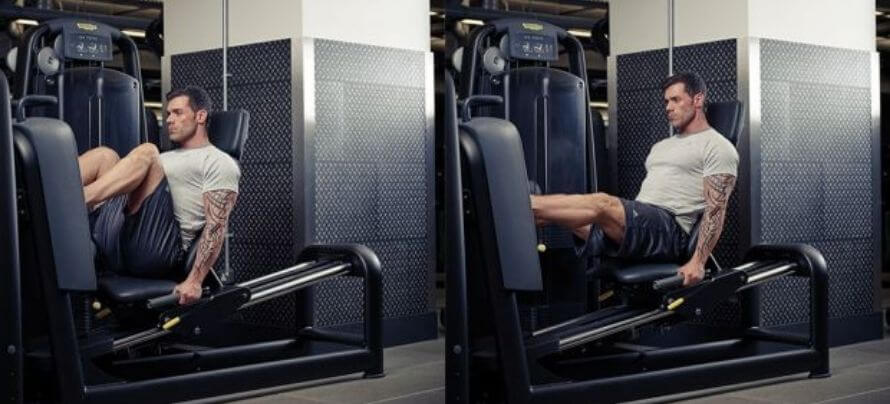
Sets: 3 | Reps: 4 to 6 | Rest: 2-to-3 min
Place your feet halfway up the footplate and a little wider that shoulder-width apart with your toes pointing slightly outward. Bend your knees slightly and use the safety handles to release the weight. Lower the footplate toward your chest, then push the footplate upward until your legs are almost but not completely straight.
Lying Leg Curl
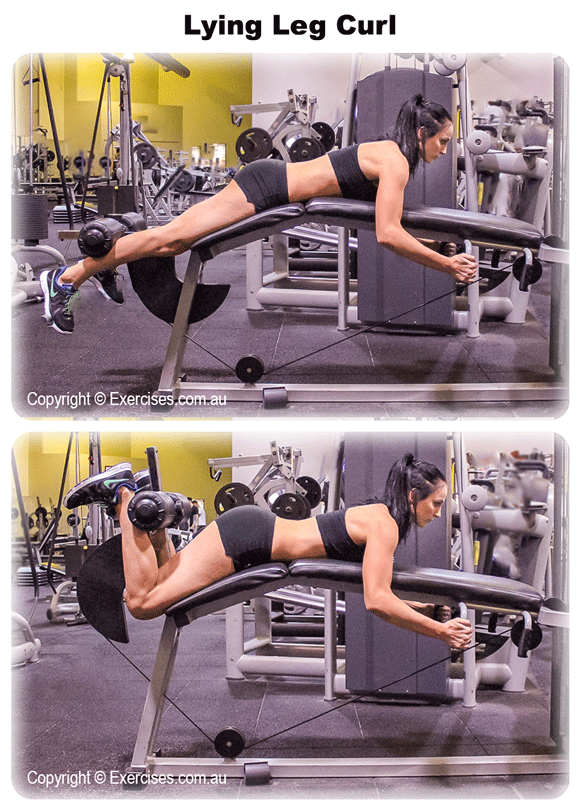
Sets: 3 | Reps: 8 to 10 | Rest: 2-to-3 min
Adjust the leg pad so that it rests just above your ankles when you lie on the machine. Lie face down and grab the handles, then curl the pad toward your butt by pushing against the leg pad. Reverse the movement and return to the starting position.
Seated Calf Raise
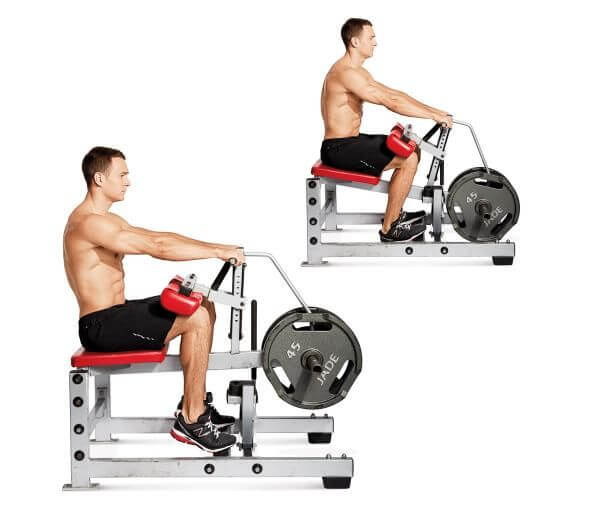
Sets: 3 | Reps: 8 to 10 | Rest: 2-to-3 min
While seated, adjust the thigh pad so that it rests just above you knee and place the balls of your feet on the footplate. Lift the pad slightly by pointing your toes, and use the safety handle to release the weight. While keeping your feet on the footplate, lower the weight as far as possible by letting your heels move toward the floor. Then, push through the balls of your feet to elevate the thigh pad as high as you can.
Close-Grip Bench Press
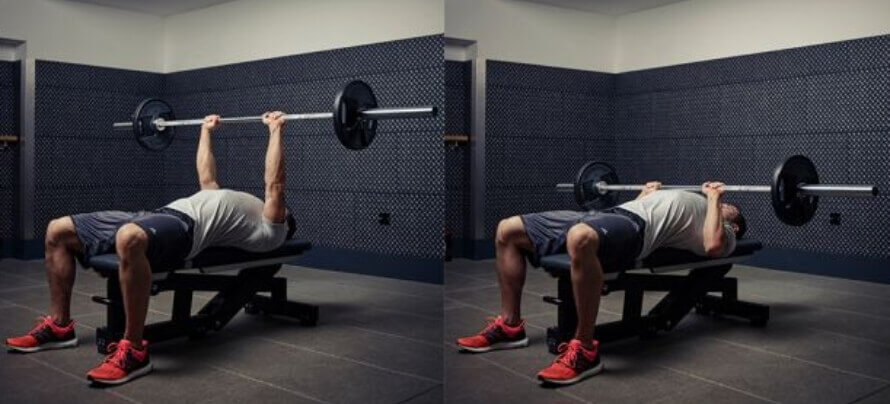
Sets: 3 | Reps: 4 to 6 | Rest: 2-to-3 min
Lie on a flat bench with your feet flat on the floor, grab the bar with a shoulder-width grip or slightly narrower, and unrack the barbell. Bring the barbell to your lower chest, then explosively press the bar back to the starting position.
Weighted Pull-up
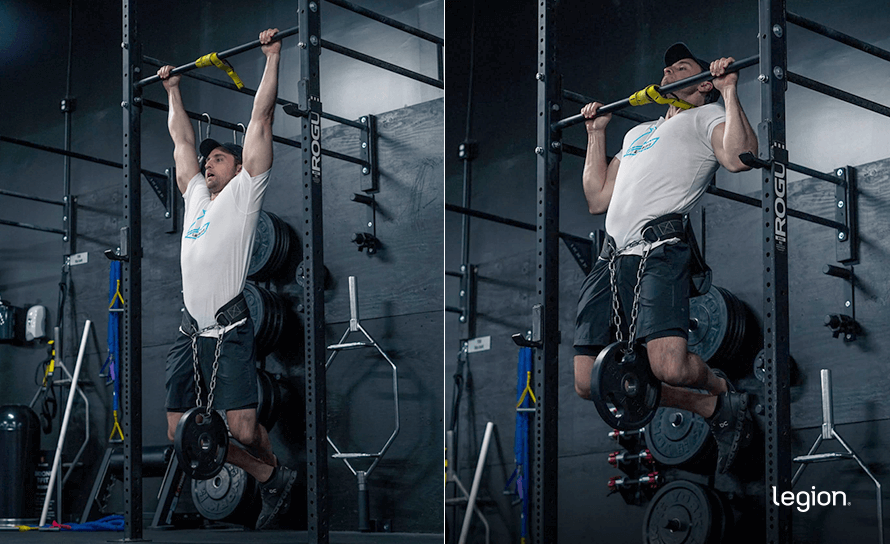
Sets: 3 | Reps: 4 to 6 | Rest: 2-to-3 min
Use a dip belt to strap a weight plate around your waist or squeeze the handle of a dumbbell between your thighs. Grab a pull-up bar and pull your body upward until your chin rises above your hands, and then lower yourself to return to the starting position.
Dumbbell Overhead Triceps Extension

Sets: 3 | Reps: 8 to 10 | Rest: 2-to-3 min
Adjust a bench so the backrest is vertical or nearly so. Grab a dumbbell and sit down on the bench. Then, grab the top end of the dumbbell so your palms are supporting the weight and extend your arms to push it over your head with your arms straight. Lower the dumbbell behind your head until your elbows are at a 90-degree angle, then extend your arms and return to the starting position.
Barbell Curl
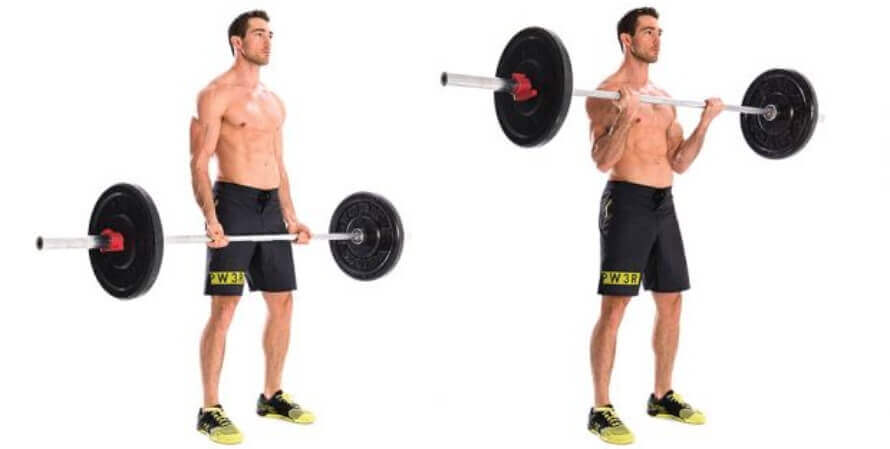
Sets: 3 | Reps: 8 to 10 | Rest: 2-to-3 min
While standing up straight, hold a barbell with your palms shoulder-width apart and facing away from you. Your arms should be straight and the bar should be resting against your thighs. Bring the bar up to shoulder height by bending at the elbow, and then lower it back to the starting position.
My Top 5 Hypertrophy Training & Diet Tips
1. Eat slightly more calories than you burn.
In order to maximize muscle hypertrophy, you need to maintain a mild calorie surplus.
That is, you need to eat about 110% of your total daily energy expenditure (TDEE) every day. The reason for this is a calorie surplus optimizes your body’s “muscle-building machinery,” so to speak, greatly enhancing your body’s ability to recover from and positively adapt to your training.
If you want to know more about how many calories you need to eat to support your hypertrophy training, check out this article:
Bulking Guide: How to Gain Weight & Muscle without Gaining Fat
2. Eat a lot of protein and carbs.
In addition to eating the right number of calories, it’s also important that you eat enough protein and carbs to boost hypertrophy and fuel your workouts.
Here’s how.
Protein: Eat 0.8-to-1 gram of protein per pound of body weight per day. This is enough to maximize muscle growth—eating more than this won’t help you bulk up faster. This usually works out to around 20-to-40% of calories for most people.
Carbs: Eat at least 2-to-3 grams of carbs per pound of body weight per day. The reason you want to follow a high-carb diet while lean bulking is that this keeps your glycogen levels topped off, which improves your performance in the gym and positively impacts genes related to muscle growth. This usually works out to around 40-to-60% of calories for most people.
Generally, the best way to set up a lean bulking diet is eat about 1 gram of protein per pound of body weight per day, set your fat intake at about 20% of calories, and fill in the rest with carbs.
3. Get enough sleep.
If you want to get the most out of your hypertrophy workout plan, you need to get enough sleep.
Research shows that insufficient sleep increases muscle loss, decreases performance, and reduces testosterone levels.
Most people need between 7 and 8 hours of sleep every night, but if you want to maximize hypertrophy, you’ll probably do better if you aim for between 8 and 9 hours per night. At the very least, you should try to get enough sleep that you can wake up without an alarm.
4. Do some cardio.
Multiple studies show that combining strength training with cardio can accelerate muscle growth, as long as you follow a few simple rules:
- Choose cycling and other low-impact cardio instead of running.
- Keep most of your cardio workouts fairly short.
- Do most of your cardio workouts on separate days from your lower-body strength training workouts.
Stick to these principles and you’ll have no issue with your cardio sessions interfering with muscle gain. In fact, they’ll likely enhance it.
If you want to know more about how to combine strength training with cardio, check out this article:
Concurrent Training: The Right Way to Combine Cardio and Strength Training
5. Take the right supplements.
I saved this for last because it’s the least important.
Unfortunately, no amount of pills and powders are going to automagically add 20 pounds of muscle to your body. In fact, most muscle-building supplements are completely worthless.
But here’s the good news:
If you know how to eat and train to build muscle—following the steps we just covered—certain supplements can speed up the process. (And if you’d like to know exactly what supplements to take to reach your fitness goals, take the Legion Supplement Finder Quiz.)
Here are the best supplements for building muscle:
- 0.8-to-1 gram of protein per pound of body weight per day. This provides your body with the “building blocks” it needs to build and repair muscle tissue and help you recover from your workouts. If you want a clean, convenient, and delicious source of protein, try Whey+ or Casein+.
- 3-to-5 grams of creatine per day. This will boost muscle and strength gain, improve anaerobic endurance, and reduce muscle damage and soreness from your hypertrophy training. If you want a 100% natural source of creatine that also includes two other ingredients that will help boost muscle growth and improve recovery, try Recharge.
- One serving of Pulse per day. Pulse is a 100% natural pre-workout drink that enhances energy, mood, and focus; increases strength and endurance; and reduces fatigue. You can also get Pulse with caffeine or without.
+ Scientific References
- Stokes, T., Hector, A. J., Morton, R. W., McGlory, C., & Phillips, S. M. (2018). Recent perspectives regarding the role of dietary protein for the promotion of muscle hypertrophy with resistance exercise training. In Nutrients (Vol. 10, Issue 2). MDPI AG. https://doi.org/10.3390/nu10020180
- Konopka, A. R., & Harber, M. P. (2014). Skeletal muscle hypertrophy after aerobic exercise training. In Exercise and Sport Sciences Reviews (Vol. 42, Issue 2, pp. 53–61). Lippincott Williams and Wilkins. https://doi.org/10.1249/JES.0000000000000007
- Mikkola, J., Rusko, H., Izquierdo, M., Gorostiaga, E. M., & Häkkinen, K. (2012). Neuromuscular and cardiovascular adaptations during concurrent strength and endurance training in untrained men. International Journal of Sports Medicine, 33(9), 702–710. https://doi.org/10.1055/s-0031-1295475
- Lundberg, T. R., Fernandez-Gonzalo, R., Gustafsson, T., & Tesch, P. A. (2013). Aerobic exercise does not compromise muscle hypertrophy response to short-term resistance training. Journal of Applied Physiology, 114(1), 81–89. https://doi.org/10.1152/japplphysiol.01013.2012
- Souissi, N., Souissi, M., Souissi, H., Chamari, K., Tabka, Z., Dogui, M., & Davenne, D. (2008). Effect of time of day and partial sleep deprivation on short-term, high-power output. Chronobiology International, 25(6), 1062–1076. https://doi.org/10.1080/07420520802551568
- Nedeltcheva, A. V., Kilkus, J. M., Imperial, J., Schoeller, D. A., & Penev, P. D. (2010). Insufficient sleep undermines dietary efforts to reduce adiposity. Annals of Internal Medicine, 153(7), 435–441. https://doi.org/10.7326/0003-4819-153-7-201010050-00006
- Creer, A., Gallagher, P., Slivka, D., Jemiolo, B., Fink, W., & Trappe, S. (2005). Influence of muscle glycogen availability on ERK1/2 and Akt signaling after resistance exercise in human skeletal muscle. Journal of Applied Physiology, 99(3), 950–956. https://doi.org/10.1152/japplphysiol.00110.2005
- Howarth, K. R., Phillips, S. M., MacDonald, M. J., Richards, D., Moreau, N. A., & Gibala, M. J. (2010). Effect of glycogen availability on human skeletal muscle protein turnover during exercise and recovery. Journal of Applied Physiology, 109(2), 431–438. https://doi.org/10.1152/japplphysiol.00108.2009
- Helms, E. R., Aragon, A. A., & Fitschen, P. J. (2014). Evidence-based recommendations for natural bodybuilding contest preparation: Nutrition and supplementation. In Journal of the International Society of Sports Nutrition (Vol. 11, Issue 1, p. 20). BioMed Central Ltd. https://doi.org/10.1186/1550-2783-11-20
- Maíra C Scarpelli, Sanmy R Nóbrega, Natalia Santanielo, Ieda F Alvarez, Gabriele B Otoboni, Carlos Ugrinowitsch, & Cleiton A Libardi. (n.d.). Muscle Hypertrophy Response Is Affected by Previous Resistance Training Volume in Trained Individuals - PubMed. Retrieved April 28, 2021, from https://pubmed.ncbi.nlm.nih.gov/32108724/
- Schoenfeld, B. J., Ogborn, D., & Krieger, J. W. (2017). Dose-response relationship between weekly resistance training volume and increases in muscle mass: A systematic review and meta-analysis. Journal of Sports Sciences, 35(11), 1073–1082. https://doi.org/10.1080/02640414.2016.1210197
- Mangine, G. T., Hoffman, J. R., Gonzalez, A. M., Townsend, J. R., Wells, A. J., Jajtner, A. R., Beyer, K. S., Boone, C. H., Miramonti, A. A., Wang, R., LaMonica, M. B., Fukuda, D. H., Ratamess, N. A., & Stout, J. R. (2015). The effect of training volume and intensity on improvements in muscular strength and size in resistance-trained men. Physiological Reports, 3(8). https://doi.org/10.14814/phy2.12472
- Carvalho, L., Junior, R. M., Truffi, G., Serra, A., Sander, R., De Souza, E. O., & Barroso, R. (2020). Is stronger better? Influence of a strength phase followed by a hypertrophy phase on muscular adaptations in resistance-trained men. Research in Sports Medicine. https://doi.org/10.1080/15438627.2020.1853546
- Schoenfeld, B. J. (2010). The mechanisms of muscle hypertrophy and their application to resistance training. In Journal of Strength and Conditioning Research (Vol. 24, Issue 10, pp. 2857–2872). J Strength Cond Res. https://doi.org/10.1519/JSC.0b013e3181e840f3
- Gentil, P., Soares, S., & Bottaro, M. (2015). Single vs. Multi-joint resistance exercises: Effects on muscle strength and hypertrophy. Asian Journal of Sports Medicine, 6(2), 1–5. https://doi.org/10.5812/asjsm.24057











